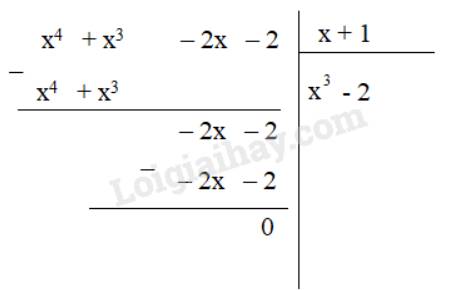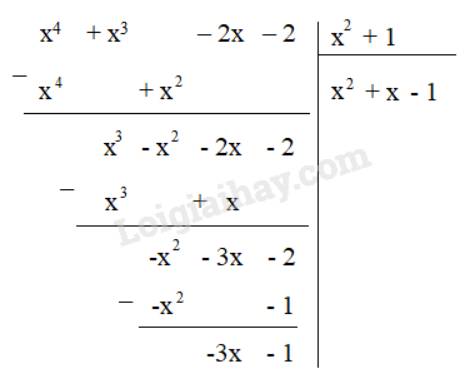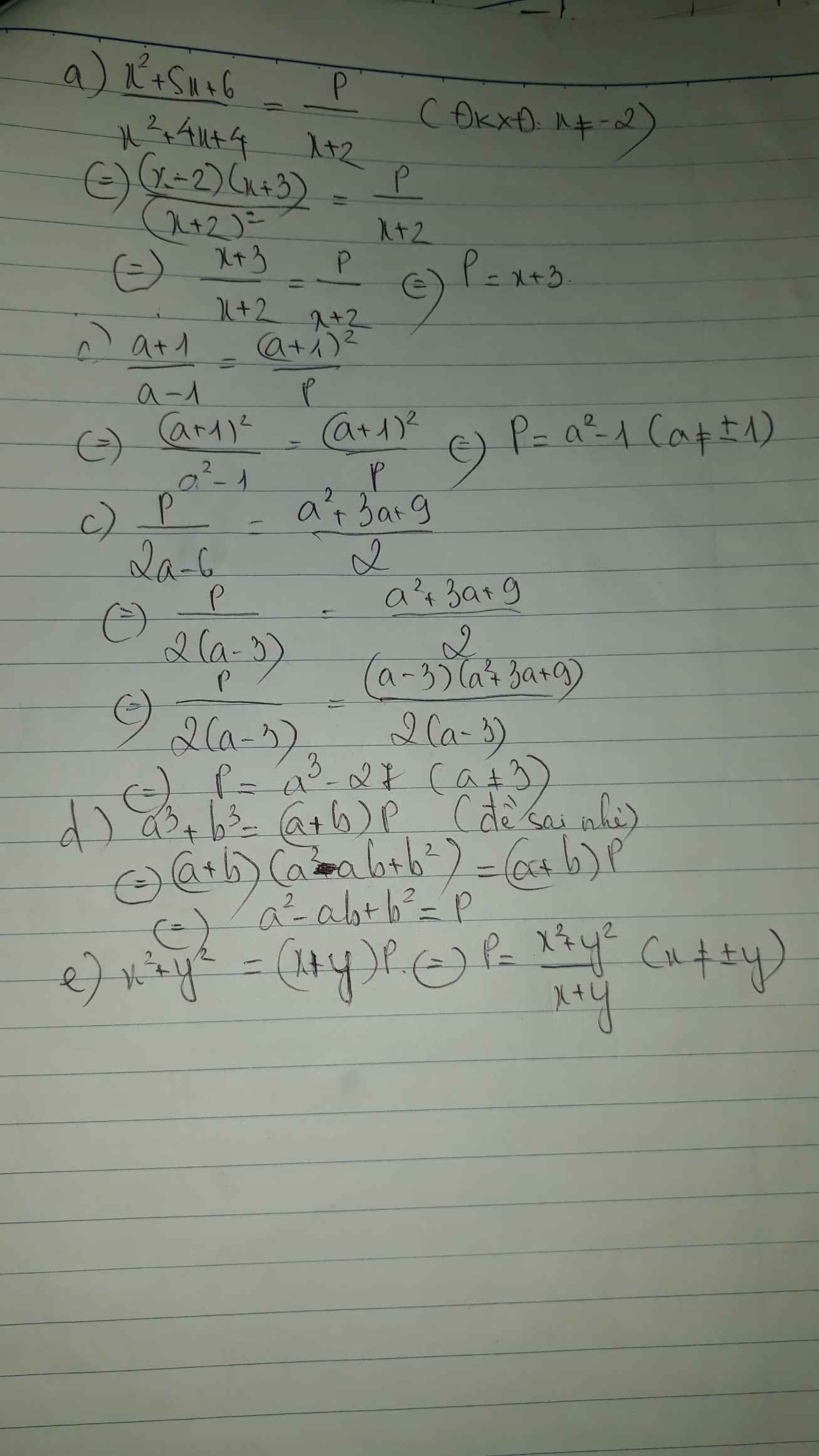cho đa thức D(x)-x2+ax.Biết D(-1)=2D (1) . Tìm a
Hãy nhập câu hỏi của bạn vào đây, nếu là tài khoản VIP, bạn sẽ được ưu tiên trả lời.


a) Ta có:
B = (A + B) – A
= (x3 + 3x + 1) – (x4 + x3 – 2x – 2)
= x3 + 3x + 1 – x4 - x3 + 2x + 2
= – x4 + (x3 – x3) + (3x + 2x) + (1 + 2)
= – x4 + 5x + 3.
b) C = A - (A – C)
= x4 + x3 – 2x – 2 – x5
= – x5 + x4 + x3 – 2x – 2.
c) D = (2x2 – 3) . A
= (2x2 – 3) . (x4 + x3 – 2x – 2)
= 2x2 . (x4 + x3 – 2x – 2) + (-3) .(x4 + x3 – 2x – 2)
= 2x2 . x4 + 2x2 . x3 + 2x2 . (-2x) + 2x2 . (-2) + (-3). x4 + (-3) . x3 + (-3). (-2x) + (-3). (-2)
= 2x6 + 2x5 – 4x3 – 4x2 – 3x4 – 3x3 + 6x + 6
= 2x6 + 2x5 – 3x4 + (-4x3 – 3x3) – 4x2+ 6x + 6
= 2x6 + 2x5 – 3x4 – 7x3 – 4x2+ 6x + 6.
d) P = A : (x+1) = (x4 + x3 – 2x – 2) : (x + 1)

Vậy P = x3 - 2
e) Q = A : (x2 + 1)
Nếu A chia cho đa thức x2 + 1 không dư thì có một đa thức Q thỏa mãn
Ta thực hiện phép chia (x4 + x3 – 2x – 2) : (x2 + 1)

Do phép chia có dư nên không tồn tại đa thức Q thỏa mãn

a) Ta có: \(\dfrac{P}{x+2}=\dfrac{x^2+5x+6}{x^2+4x+4}\)
\(\Leftrightarrow\dfrac{P}{x+2}=\dfrac{\left(x+2\right)\left(x+3\right)}{\left(x+2\right)^2}=\dfrac{x+3}{x+2}\)
hay P=x+3

a/\(x^2+9=0\)
\(\Rightarrow x^2=-9\)(Vô lí vì \(x^2\ge0\))
Do đó A(x) vô nghiệm
b/\(x^2-9=0\)
\(\Rightarrow x^2=9\)
\(\Rightarrow\left[{}\begin{matrix}x=3\\x=-3\end{matrix}\right.\)
Vậy nghiệm của B(x) là \(x\in\left\{3;-3\right\}\)
c/\(2x^2-2=0\)
\(\Rightarrow2x^2=2\)
\(\Rightarrow x^2=1\)
\(\Rightarrow\left[{}\begin{matrix}x=1\\x=-1\end{matrix}\right.\)
Vậy nghiệm của C(x) là \(x\in\left\{1;-1\right\}\)
d/\(3x-6=0\)
\(\Rightarrow3x=6\)
\(\Rightarrow x=2\)
Vậy nghiệm của D(x) là \(x=2\)
a: A(x)=0
=>x^2=-9(loại)
b: x^2-9=0
=>x^2=9
=>x=3 hoặc x=-3
c:2x^2-2=0
=>x^2-1=0
=>x=1 hoặc x=-1
d: 3x-6=0
=>3x=6
=>x=2

\(\dfrac{f\left(x\right)}{2x+1}=\dfrac{\left(2x+1\right)\left(x^2-x+1\right)}{2x+1}=x^2-x+1\)

a: \(C\left(x\right)=x^3+3x^2-x+6\)
\(D\left(x\right)=-x^3-2x^2+2x-6\)
b: Bậc của C(x) là 3
Hệ số tự do của D(x) là -6
c: \(C\left(2\right)=8+3\cdot4-2+6=20-2+6=24\)
d: \(C\left(x\right)+D\left(x\right)=x^2+x\)
a. C(x)=x^3+3x^2−x+6C(x)=x3+3x2−x+6
D(x)=−x^3−2x^2+2x−6D(x)=−x3−2x2+2x−6
b. Bậc của C(x) là 3
Hệ số tự do của D(x) là -6
c. C(2)=8+3⋅4−2+6=20−2+6=24C(2)=8+3⋅4−2+6=20−2+6=24
d. C(x)+D(x)=x2+x

b: \(=\dfrac{2x^4-2x^3-2x^2-3x^3+3x^2+3x+x^2-x-1}{x^2-x-1}\)
\(=2x^2-3x+1\)

Ta có: D(-1)=2D(1)
\(\Leftrightarrow-\left(-1\right)^2+a\cdot\left(-1\right)=2\cdot\left[-1^2+a\cdot1\right]\)
\(\Leftrightarrow-a-1=2\left(-1+a\right)\)
\(\Leftrightarrow-a-1=-2+2a\)
\(\Leftrightarrow-a-1+2-2a=0\)
\(\Leftrightarrow-3a=-1\)
hay \(a=\dfrac{1}{3}\)